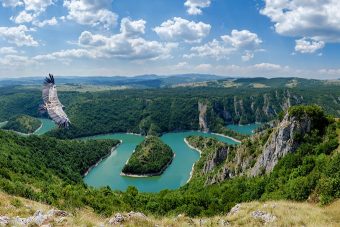
The municipality of Nova Varoš has a considerable hydropower potential. Hydro power plants ‘Uvac’, ‘Kokin Brod’, ‘Potpeć’ and reversible hydro power plant ‘Bistrica‘ are located on the territory of the municipality. In order to present the potential of the municipality, the Energy Portal has talked to an independent expert associate for Agriculture and Rural Development of Nova Varoš municipality, Mr Milinko Šaponjić.
The hydro power plant ‘Bistrica’ is the first hydro power plant built on the river Uvac, in the municipality of Nova Varoš. The plant was put into operation in 1960, and the type of hydro power plant is an impoundment facility. The power of HPP ‘Bistrica’ is 104MW and this is the largest hydro power plant on the Uvac river. HPP ‘Kokin Brod’ with powerhouse at the toe of the dam was put into operation in 1962. This hydro power plant has two generators of total power of 22.5MW. HPP ‘Potpeć’ with powerhouse at the toe of the dam was put into operation in 1967. This power plant is also located on the Uvac river, and it has the power of 54MW. It annually produces about 180 million kWh of electricity. The last built HPP on the Uvac river is eponymous HPP ‘Uvac’. This HPP was put into operation in 1979, and it has the power of 36MW. This power plant is of diversion type, and it produces around 70 million kWh of peak energy annually.
EP: What are the main hydro potentials of Nova Varoš municipality?
Milinko Šaponjić: The main hydro potential of the municipality are three hydro power plants located on the rivers Uvac and Lim, the impoundment hydro power plant ‘Bistrica’ but also the small ones.
EP: How many SHPP are in the possession of Nova Varoš municipality?
Milinko Šaponjić: The municipality owns three small hydro power plants which are located on the Bistrica river. Those are SHPP ‘Rečice’ of the installed power of 930kW, SHPP ‘Crkvine’ of the installed power of 850kW and SHPP ‘Hydra-electro’ of the installed power of 100KW.
EP: Spatial Plan of Nova Varoš municipality envisages the construction of 20 small hydro power plants. How far did you come with the implementation of these projects?
Milinko Šaponjić: Our municipality is competent for issuing permits for construction of 6 SHPP, while the Ministry of Construction, Transport and Infrastructure of the republic of Serbia is competent for the other 14, due to the fact that they are within the limits of the Spatial Plan for the special purpose areas of the Uvac Special Nature Reserve. So far, building permits for four small hydro power plants have been issued that are under the jurisdiction of Nova Varoš municipality.
EP: There is a plan for the construction of HPP ‘Bistrica 2’. At what stage is the implementation of the project?
Milinko Šaponjić: There are still no requests for issuing the necessary permits for the implementation of this project. In the local energy plan the construction of this project has been defined as one of the priority projects of the municipality and the corresponding Ministry. There is a huge interest of investors, and at the moment we are negotiating on developing of the Feasibility Study with Preliminary Design and Environmental Impact Assessment on the environment. It is expected that HPP ‘Bistrica 2’ will have the installed power of 680MW, while the investment value is 600 million euros.
In addition to hydro potential, biomass represents huge energy potential of Nova Varoš municipality. Thus the municipality developed the Study ‘The Potential and Possibilities of Using Biomass for Energy Production and Economic Development of Nova Varoš, Priboj and Prijepolje’ in 2009. This study showed that the wood biomass energy potential of Nova Varoš is higher compared to the heavy fuel oil energy for 4.95 million kWh. This means that the available quantities can fully meet the users’ need for energy, but also that they can enable the expansion of existing capacity and the network of users or running cogeneration plants for the production of electricity and heat which will use biomass as an energy source.
This text was originally published in the Energy Portal bulletin “Renewable Energy “, which was released on June 1, 2016.
Interview by: Sandra Jovićević





